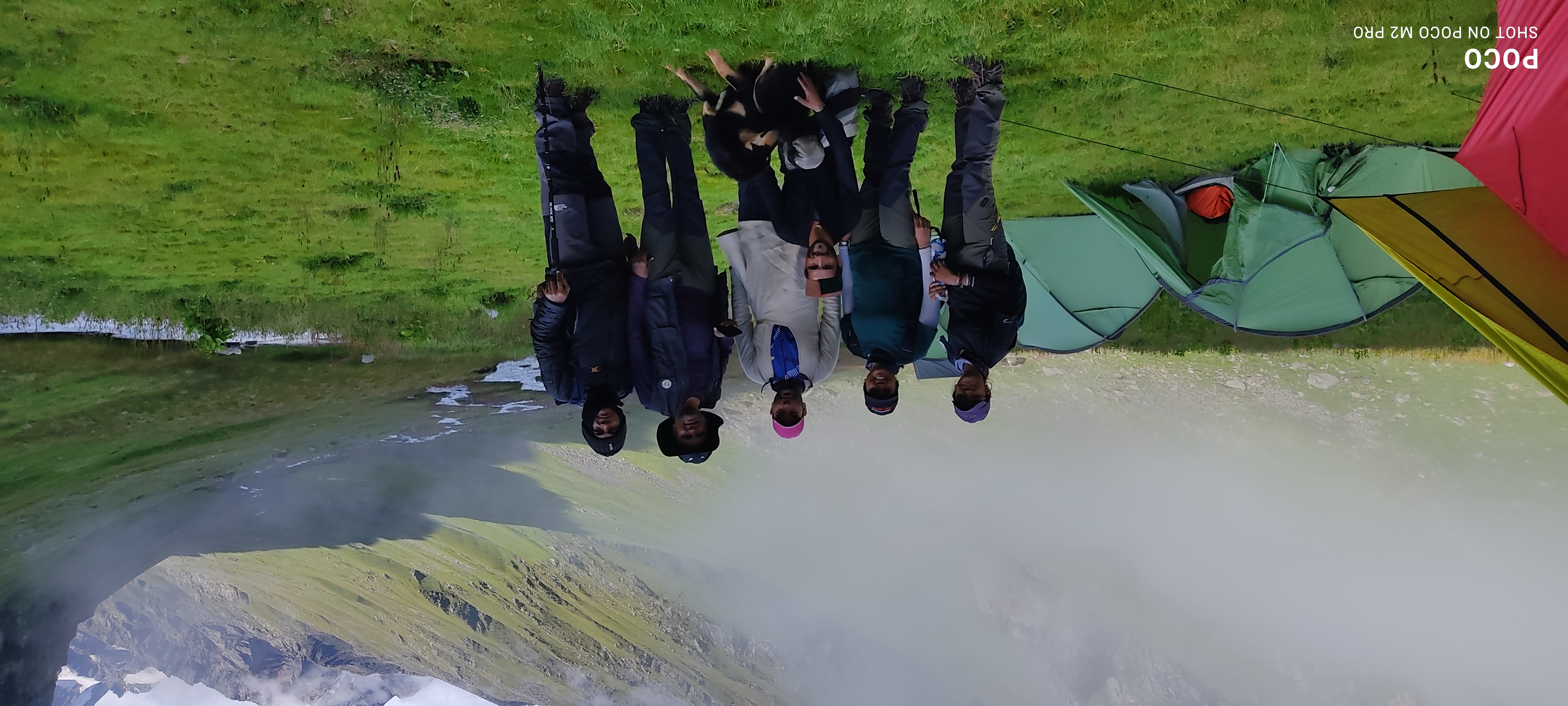
Tirthan Valley Trek
TREK DIFFICULTY
Easy
TREK DURATION
5 Days
HIGHEST ALTITUDE
14,107 feet
GROUP SIZE
12
TREK DISTANCE
70 KM
BASECAMP
Himachal Pradesh
BEST TIME
March to June
PICKUP POINT
Himachal Pradesh
Tirthan Valley Trek
Tirthan Valley is one of the most beautiful valleys of our country. This beautiful valley is situated in the Kullu distance of Himachal Pradesh. Tirthan Valley is the entry point to the Great Himalayan National Park, a UNESCO World Heritage site. The valley is known for its dense forests and alpine meadows. The Tirthan Valley trek begins from Gushini which is home to the Tirthan River. You can witness a crystal-clear river flowing gently alongside your trek. It is an easy-rated trek as all the ascends and descends on the trek are smooth. The trails are well-marked and have photogenic landscapes.
Trekkers can start the trek from various locations. Most trekkers start trekking from Mashyar. This trek can range from 2-10 days depending on the route and remoteness. Beginners usually plan for a 4-5 day trek. Experienced trekkers often opt for expeditions that can take 8-10 days. People can spot various unique flora and fauna on the trek. They can spot Monals, Musk Deer, and various other wildlife. This trek is also home to a variety of fauna with good medicinal value. Tirthan Valley lies inside the protected zone; trekkers will need a permit to enter the valley. Tirthan Valley Trek is for the people who seek raw nature and culture.
History of Tirthan Valley Trek
Tirthan Valley Trek is a trail to God. The word “Tirthan” comes from “Tirath” which means sacred place. This is a spiritually and culturally rich valley of Himachal Pradesh. The name of the valley is after the Tirthan River which originates from Tirath Glacier. The locals of the valley consider it a holy destination. Some of the local stories say that yogis and sages used to travel to Tirthan Valley for meditation.
Today, Tirthan Valley has become a famous destination for tourists. However, not many people know about the trek. The Tirthan Valley Trek is a culturally rich trek followed by beautiful rivers, streams, forests, and meadows. It is an isolated area and the locals have preserved their language, traditions, and old customs. Today the valley is a UNESCO World Heritage Site that helps the locals to protect the flora and fauna. The trek is very famous among people who like bird watching, wildlife/nature photography, etc. Tirthan Valley Trek is a culturally rich and less-crowded trek. You will be walking on a living heritage site.
Highlights of Tirthan Valley Trek
Arch to the Great Himalayan National Park: Tirthan Valley is the gateway for GHNP and the trek is the trail to one of the most beautiful valleys in our country. Tirthan Valley Trek covers various protected biodiversity zones. Trekkers can witness big alpine meadows, high-altitude landscapes, and dense forests.
Flora And Fauna: Your Tirthan Valley trek passes from various protected zones. These zones are home to various unique flora and fauna. While walking in these sensitive zones, trekkers can witness wildlife like Monal, Snow Leopard, Himalayan Tahr, etc. You can find countless species of fauna and wildflowers.
Beautiful Himalayan Villages: Himalayan villages are very difficult. They are not only culturally rich but the people are also very nice and friendly. You will start your trek from Gushaini village where you can experience the warmth of locals. The hospitality is very exceptional and you can also find lots of homestays with local cuisine. These villages will aid the bliss of your trek.
Scenic valleys and rivers: The valleys and villages are very beautiful. When you trek Tirthan Valley, a beautiful Tirthan river will follow you. You will see natural pools, and hidden waterfalls on the trek. You might pass small bridges to cross the river. The small river and waterfall crossing make the trail more scenic.
Difficulty Level of Tirthan Valley Trek
Tirthan Valley Trek is rated as an easy trek. It is a beginner-friendly trek and you can complete your trek without any difficulty. Meanwhile, the trekkers should be fit to walk long hours. Trekking to Tirath requires good physical and mental strength.
- Easy to moderate trails: You start your trail from Mashyar and trek to Asurbag which has an altitude of 12,470 ft. The trail is not very difficult but you have to walk for long hours. Most trails are easy but you should always prepare yourself for moderate trails.
- High-altitude sickness: People who are not used to thin air can face AMS problems. While walking in high-altitude areas, the low oxygen level often causes symptoms like nausea, headache, etc. Trekkers should stay at Gushaini for a day for acclimatization and start the trek the next day.
- Unpredictable weather: The weather in high-altitude locations is unpredictable. Trekkers may experience sunny, rainy, or even snowfall on the same day. The days can be hot and the nights can be extremely cold. The trekkers should always carry rain gear for the Tirthan Valley trek. If you are equipped with all essential gear, you can complete your trek without any worry.
Best Time To Visit Tirthan Valley Trek
The best time to plan your Tirthan Valley Trek depends on what you want to experience. For easy treks, you can plan your trek during spring or autumn. But, if you like snow then you can plan your Tirthan Valley Trek in the winter.
- Tirthan Valley Trek from March To April
People who love cool weather, dense forests, and beautiful meadows should plan the trek during spring. The snow starts melting and the meadows start turning green. The valley looks very vibrant and lively.
- Tirthan Valley Trek from May To June
Trekkers who want to escape the harsh summer of their city can plan a trek from May to June. The weather will be good and the trail will be lush green. Trekkers can witness the calm flowing Tirthan River with clear skies.
- Tirthan Valley Trek from July To September
Monsoon in the Himalayas can be risky. You can trek to the lower parts of the Tirthan valley but high-altitude treks are not recommended. Clouds will cover your Himalayan views and camping will also become difficult. Getting leeches and other wild insects is very common. But you can witness big meadows covered with wildflowers.
- Tirthan Valley Trek from Mid September to November
Autumn is also a good time to plan the Tirthan Valley trek. The temperature will start dropping and views become clearer. This is the best time to plan high-altitude treks.
- Tirthan Valley Trek from December To February
This season is only for snow lovers. You can experience heavy snowfall in high-altitude areas. In winter, Tirthan Valley becomes a paradise for snow lovers. But you can only trek to the low-altitude areas.
How To Reach Tirthan Valley Trek?
Tirthan Valley is situated in Kullu, Himachal Pradesh. This valley is the entry point to the Great Himalayan National Park. To reach Tirthan Valley, you need to reach Gushaini or Mahsyar.
- Route 1: Delhi to Aut
You can take a bus, flight, or train to reach Delhi from your hometown. Now you can ride a bus directly to Aut. The distance is about 500 km and will take about 12-14 hours. Aut is a small town near the Chandigarh-Manali highway. After reaching Aut, you can take a shared taxi to Gushaini.
- Route 2: Chandigarh to Aut
Chandigarh is also a good option to reach Aut. This city has good train, road, and air connectivity. After reaching Chandigarh, look for the direct buses to Aut. The distance is 250 km and will take about 7-8 hours.
You can find local taxis from Aut to Gushaini. A few local bus services are also available for Aut to Banjar and then Banjar to Gushaini. The nearest airport is Bhuntar Airport which is 20 km from Aut. The nearest railway station is Joginder Nagar Railway Station but it has limited trains. Chandigarh or Ambala stations are better options for railway connectivity.
Day 1: Reach Gushaini in the morning and drive to Mashyar. Now trek to Asurbag via Bedi Thatch. The Trek distance is 15 km and will take 9-10 hours.
Day 2: Trek from Asurbag to Khukhri (12,467 ft) via Dhunga. The Trek distance is 12 km and will take 8-9 hours.
Day 3: Trek from Khukhti to Tirath (12,140 ft). The trek distance is 5 km and will take 2-3 hours.
Day 4: Trek from Tirath to Shankha Thach. The Trek distance is 18 km and will take 9-10 hours.
Day 5: Trek from Shankha Thach to Gushaini via Holla Thach. The Trek distance is 20 km and will take 10-11 hours.
Tirthan Valley Trek is a beautiful and less-crowded trek of Himachal Pradesh. Plan your Tirthan Valley Trek with the Himalaya Shelter and get customized services. Our company provides a tailored plan for the trekkers. If you are a beginner and planning your Tirthan Valley Trek; we are with you. Our team will take care of everything. This is the call for all the nature lovers who want to explore this UNESCO world heritage site of Himachal Pradesh. We plan treks that provide the best and smooth experience to our trekkers. Our trek designs are specified as your goals and interests.
Himalaya Shelter is a team of experienced guides and management who plan your treks as per your dates, routes, and other plans. Our treks are always eco-friendly and adventurous. Book your customized Tirthan Valley Trek and experience the best.
Day 1: Drive from Gushaini to Mashyar and Trek to Asurbag campsite (12,470 ft) via Bedi Thatch | Drive: 16 km in 30 min. approx; Trek: 15 km in 9 - 10 hrs
Day 2: Asurbag to Khukhri (12,467 ft) via Bagoda Dhunga | Trek: 12 KM in 8 - 9 hrs
Day 3: Khukhri to Tirath (12,140 ft) | 5 km in 2 - 3 hrs
Day 4: Tirath to Saketi (14,107 ft); and Trek to Shankha Thach ( 11,483 ft) | Trek: 18 KM in 9 - 10 hrs
Day 5: Shankha Thach to Gushaini via Holla Thach (12,467 ft) | Trek: 20 KM in 10 - 11 hrs
Our treks are specially designed by the experienced team at Himalaya Shelter taking you on an adventure of a lifetime all while making you connect not only with the bountiful nature but also with yourself and with others on the trek with you creating wonderful memories which will last you a lifetime. All Himalaya Shelter treks are guided by experienced Trekkers having vast knowledge and experience of the region, providing with insightful information and stories pertaining to the region’s flora and fauna and the history of the region whilst the trek. It is safe to say that on successfully completing the trek one will gain tremendous insight and experience along with lifetime memories.
Trek Inclusions
- Transportation - Drive from Shimla to Kafnu at an additional cost of INR 2,000 per person. Pickup time: 6:30 am, Old Bus Stand, Shimla ( Last Day: Drive from Mud to Manali at an additional cost of INR 3,000 per person. Expect to reach Manali by 6:30 PM. )
- Accommodation – At Base Camp, stay at a local homestay or guest house for one night each, which will give you an insight into the authentic lifestyle of the locals.( INR 5000 per person extra for single sharing throughout the trek )
On Trek stay in a 2-person Vango Halo Pro/A-Shape tent, which is to be shared by two trekkers, built to withstand extreme weather conditions and at the same time making you comfortable after a hard day’s trek. - Camping Equipment – specially designed sleeping bags that can withstand harsh weather conditions, foam mattresses. Other safety gear like microspikes, gaiters, an ice axe, and helmets will be provided.
- Medical Kit – our team will be equipped with an extensive medical kit, which our team is trained and experienced to use. Oxygen cylinders are used after they are thoroughly inspected throughout the Trek. Even campsites have large oxygen cylinders as backups.
- Permission - Forest entry charges for Indian nationals (Additional charges will be applicable for international tourists)
- Meals – Breakfast, packed lunch (on trek days), evening snacks, and dinner will be served. A hearty, delicious, and nutrition-filled Veg meals with egg preparation will be provided throughout the trek. (Jain and Vegan Food can also be arranged on prior notification.)There will be a dedicated Kitchen Tent along with a dining tent, which will have a dining table too.
- Our Team – A highly experienced and AMC-certified Trek Leader who will help ensure that the entire trek goes smoothly and safely while navigating the challenging conditions during the trek, and is skilled enough to navigate any medical emergency that can arise during the trek. Local and route Guides who are well-versed with the region and provide an in-depth insight into the local customs and knowledge of the flora and fauna endemic to the region. A dedicated Kitchen staff, which includes a Cook, a helper, and other support staff. There will also be porters and mules to carry common equipment.
- Cloakroom - We have a cloakroom facility available for extra luggage. Every trekker is permitted to leave their luggage behind at no charge.
Trek Exclusions
- Personal expenses like tips, personal medicines, phone calls etc.
- Travel Expenses - Travel expenses from your hometown to the mentioned Pick-Up Point are not included in the trek fee.
From the scheduled pick-up spot to the base camp, we have our own fleet of vehicles like Bolero, Innova, Dezire, or Tempo Traveler (12-seater). This is be shared by trekkers for a pre-decided amount. All vehicles are non-AC. - Personal Equipment - Any personal gear like jackets, shoes, cutlery, or backpacks are not included in the trek fee. We recommend renting them from our Rental Store for an affordable fee. This can be pre-arranged to avoid last-minute hang-ups.
- Offloading - We encourage carrying your backpack to get into the true spirit of trekking. However, if needed, you can opt to offload your personal luggage of up to 12 kgs for an additional cost of INR 500 per bag per day.
- Trek Insurance - A mandatory trek insurance fee is charged in addition to your trek fee. Since most medical insurance doesn’t cover adventure activities, trek insurance offers essential coverage, enhancing your safety without a significant financial burden.
- Buffer day on the trek - We have kept a buffer day on the trek to account for any weather-related delay. If this is utilized, you will need to pay an extra amount to your trek leader.
- Anything apart from inclusions
- Please carry a lunch box for a packed lunch/breakfast to avoid using polythene and Aluminium foil.
Keeping the Himalayas clean is our own responsibility. Reduce the use of Plastic when you are in the abode of the Sacred Himalaya. 🌱
Yes, Tirthan Valley is a part of GHNP and you will need a permit to enter the valley.
You can plan your Tirthan Valley Trek in spring or autumn.
Yes, but you can only explore the low-altitude areas.
You can find a few riverside homestays and campsites in Tirthan Valley.
Read More on Tirthan Valley Trek
Treks by Categories
Treks By Month

Treks By Experience















